Witness the fascinating world of bees through their five eyes and discover why they need so many to navigate their environment.
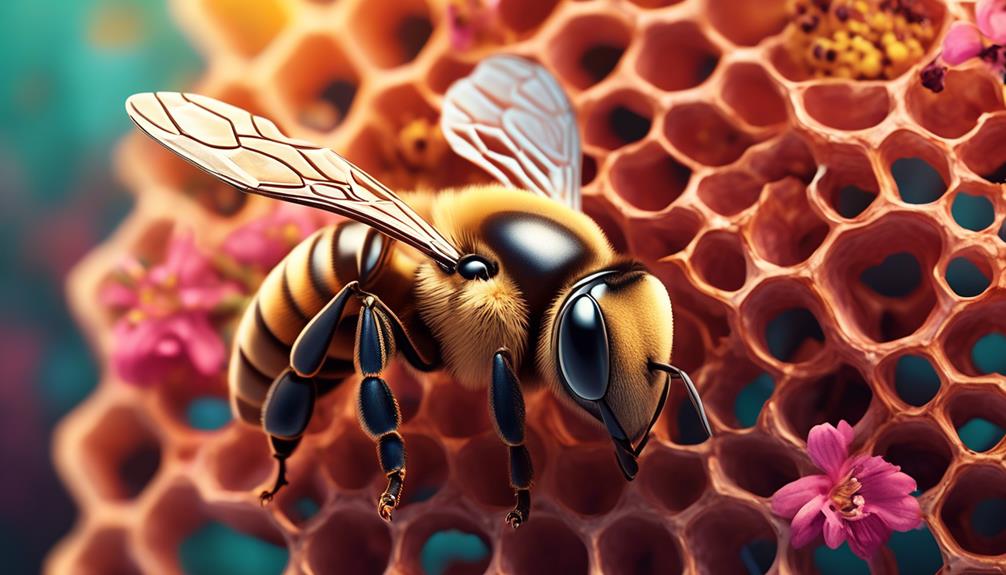
How Many Eyes Do Bees Have?
Imagine you're watching a honeybee as it flits from flower to flower in your garden. You might casually think that it sees the world in the same way you do. However, the reality is far more complex and fascinating.
A bee doesn't have just one pair of eyes; it has five. Yes, five. This peculiar fact might prompt you to question why a creature as small as a bee would need so many eyes. It's an interesting query, isn't it?
The answer lies in the unique way bees perceive their environment, a topic that invites further exploration.
Key Takeaways
- Bees have two types of eyes: compound eyes and simple eyes called ocelli.
- Compound eyes provide a wide-angle view, detect motion and colors, and can see ultraviolet light.
- Simple eyes (ocelli) detect changes in light intensity and aid in navigation and speed regulation during flight.
- Bee vision is crucial for their daily tasks, such as pollination, and understanding it helps appreciate their role in the ecosystem.
Understanding Bee Anatomy
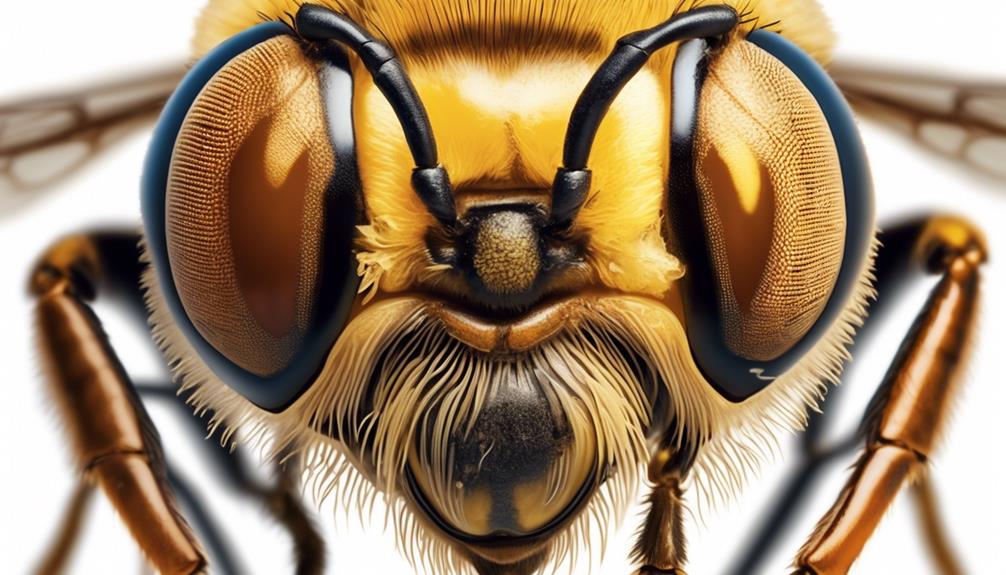
Diving into the world of bee anatomy, you'll soon discover that these tiny pollinators are far more complex than they first appear. Each bee, regardless of species, is a miracle of nature's engineering, with every part of its body designed for a specific function.
Let's start with the head, a sensory powerhouse. Here, you'll find the antennae, used for smell and touch, and the eyes. That's right, eyes. Bees have five of them – two large compound eyes on the sides of the head and three smaller ocelli on top. The compound eyes are made up of thousands of tiny lenses, capturing light and color, while the ocelli are simpler, mainly detecting light intensity.
Moving to the thorax, you'll see the wings and legs. It's here the bee's incredible flying capabilities come into play, with its wings beating up to 200 times per second. The legs, each having a specific role, are also crucial for pollen collection.
Then there's the abdomen, housing the digestive and reproductive organs, and the stinger, a bee's primary defense.
In this intricate design, it's clear that every aspect of bee anatomy plays a crucial role in their survival.
The Function of Bee Eyes

Now, let's delve into the fascinating function of a bee's eyes, which are as intricate and vital as any other part of its anatomy. You'll find that bees have two types of eyes: compound and simple.
The compound eyes, large and bulbous, are primarily used for detecting motion and colors. They're made up of thousands of tiny lenses, each capturing a pixel of the visual field. This allows bees to see a wide, almost 360-degree view of their surroundings.
On the other hand, the three simple eyes, known as ocelli, are located on the top of a bee's head. These eyes aren't for detail but for measuring light intensity. They help bees navigate, especially during the darker hours of dawn and dusk.
Additionally, it's fascinating to note that bees perceive the world differently than humans do. They can see ultraviolet light, which humans can't, enabling them to detect patterns on flowers that guide them to nectar. Hence, a bee's eyes aren't just windows to the world but sophisticated, multi-functional tools that aid in their survival.
Explaining Compound Eyes
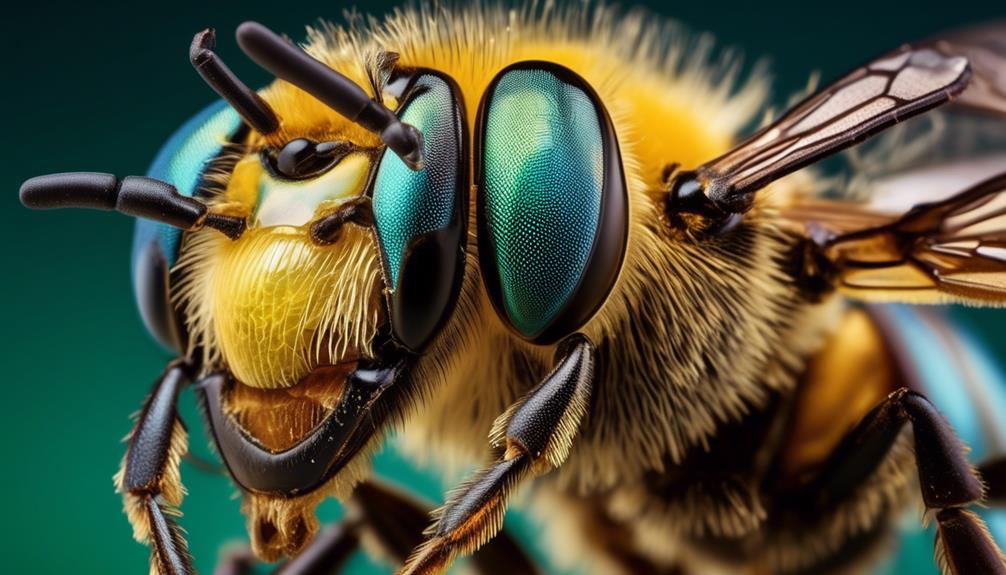
To truly appreciate the intricate design of a bee's compound eyes, you need to understand that these visual marvels comprise thousands of minute lenses, each playing a crucial role in the bee's perception of its environment. These lenses, or 'ommatidia', work together to form a mosaic image that, while not as sharp as the images we humans perceive, provides the bee with a wide-angle view of the world. It's like having built-in panoramic vision.
Each ommatidium captures a tiny portion of the bee's field of view and combines it with the others, like a jigsaw puzzle, to form a complete image. This gives bees a remarkable ability to detect fast movement, allowing them to react quickly to threats or opportunities.
Additionally, the structure of the compound eyes allows bees to see ultraviolet light, which is invisible to humans. This ability is crucial for bees as many flowers reflect UV light, helping them to locate and identify flowers from which to gather nectar.
All these factors together illustrate how the bee's compound eyes provide a perfect blend of form and function, facilitating survival in its bustling, airborne world.
The Role of Simple Eyes
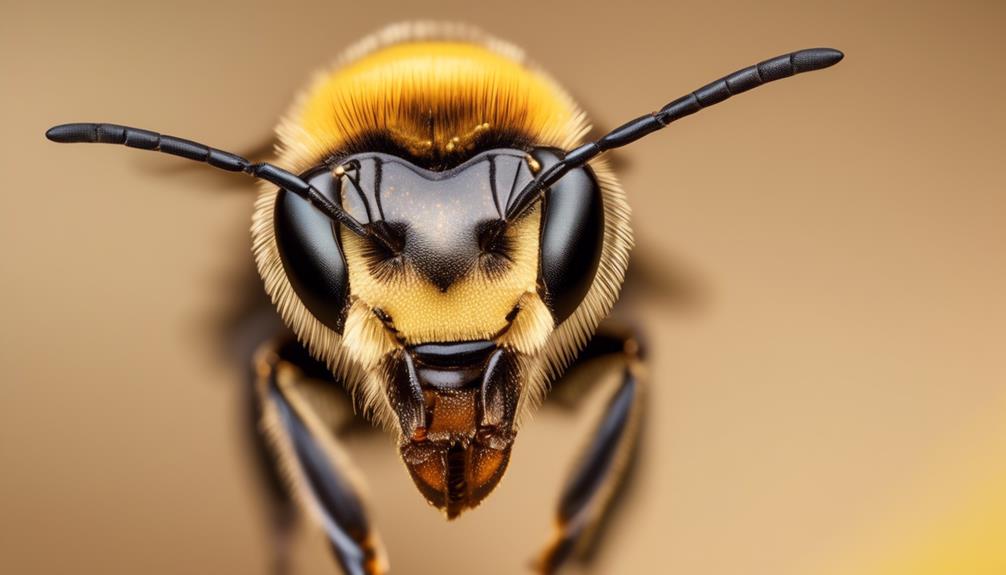
In addition to their compound eyes, bees also possess three simple eyes, or 'ocelli', which play a vital role in their navigation and orientation. These simple eyes aren't for detailed vision like the compound eyes; instead, they're more about perceiving light intensity.
Think of these ocelli as a sort of biological compass. They help bees orient themselves by detecting light, particularly the polarization of sunlight. You see, sunlight gets polarized when it passes through the Earth's atmosphere, and these simple eyes are sensitive to such changes. This amazing capability allows bees to navigate and orient themselves even on a cloudy day when the sun isn't directly visible.
But there's more to these ocelli. Research has shown that the simple eyes also play a role in speed regulation during flight. By monitoring the passing scenery against the bright sky, bees can adjust their speed accordingly. This is crucial during their foraging flights and when returning to the hive laden with pollen and nectar.
Intricacies of Bee Vision
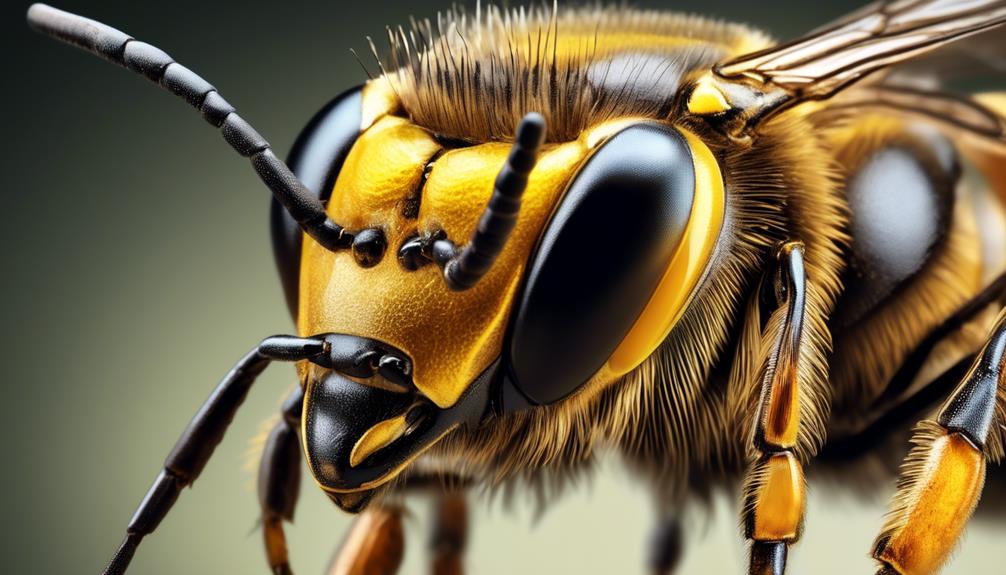
Diving deeper into the complexities of bee vision, you'll find a world that's incredibly intricate and remarkably adapted to the bees' ecological needs. Bees' eyes are designed for maximum efficiency in their daily tasks. They've two types of eyes: compound and simple, both serving distinct purposes.
The compound eyes, made up of thousands of tiny lenses, allow bees to detect light, color, and movement. They can see ultraviolet light, which is invisible to us, and it helps them find flowers. Bees perceive the world in a mosaic of hexagonal images, each representing a small part of the overall visual field. This, combined with their advanced perception of motion, makes them adept at navigating their surroundings.
Their simple eyes, or ocelli, on top of their head, aren't for forming images. Instead, they sense light intensity and the direction of the sun. This plays a crucial role in their remarkable navigation skills, aiding them to return to their hive from distances up to 5 miles.
Understanding these intricacies of bee vision helps us appreciate not only the sophistication of these tiny creatures but also their vital role in pollination and our ecosystem.
Frequently Asked Questions
Can Bees See Colors That Are Invisible to Humans?"
Yes, you're correct. Bees can indeed see colors that are invisible to humans. They've got the ability to perceive ultraviolet light, a color spectrum humans can't see. This helps them locate flowers for pollination.
It's quite fascinating how nature equips its creatures with such unique abilities, isn't it?
However, it's worth noting that they can't see the color red, which appears as black to them.
How Do Bees Interpret Their Visual Information?"
You're asking how bees interpret visual information.
Bees process visuals differently than humans. They see the world in a combination of ultraviolet, blue, and green light, which helps them identify different types of flowers.
Their eyes are designed to detect movement and they're excellent at determining direction due to their ability to see polarized light.
Essentially, bees comprehend their surroundings through a complex, color-coded system.
Do All Species of Bees Have the Same Number of Eyes?"
Yes, all bee species share the same eye structure. They've got five eyes: two large compound eyes and three smaller ocelli eyes in the center of their head. The compound eyes provide detailed images, while the ocelli eyes detect light intensity.
Nature's equipped them perfectly for their role as pollinators, allowing them to find flowers efficiently. So, regardless of the species, bees have a sophisticated visual system.
Has the Bee's Vision Evolved Over Time?"
Yes, bees' vision has evolved over time. It's believed that this evolution is primarily driven by their need to locate and recognize flowers. They've developed the ability to see ultraviolet light, which isn't visible to humans. This helps them spot patterns on flowers that act like landing strips, leading them to the nectar.
How Do Bees' Eyes Compare to the Eyes of Other Insects?"
You're delving into the fascinating world of insect vision. Bees, like many insects, possess compound eyes. These eyes, made up of numerous tiny lenses, offer a wide field of vision. However, they lack the clarity that single-lens eyes provide.
Compared to other insects, bees' vision is quite advanced. They can detect ultraviolet light and polarized light, which aids them in navigating and finding flowers. It's an intricate system, perfectly adapted for their needs.
Conclusion
So, you've now discovered bees' fascinating vision system. They possess five eyes, two compound, and three simple ones, each with a distinct role.
Their compound eyes offer a wide, panoramic view while the simple eyes detect light. This unique setup aids in foraging and navigation.
Understanding the intricacies of bee vision gives us a deeper appreciation for these industrious pollinators, doesn't it? Nature is truly remarkable in its design, and bees are no exception.



